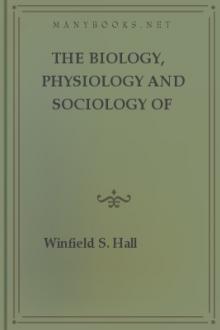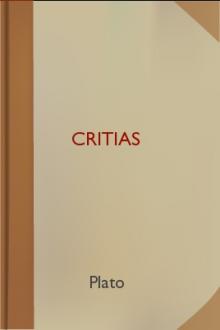Illusions, James Sully [speld decodable readers .TXT] 📗

- Author: James Sully
- Performer: -
Book online «Illusions, James Sully [speld decodable readers .TXT] 📗». Author James Sully
In view of this wide far-reaching area of ascertained error, the mind naturally asks, What are the real limits of illusory cognition, and how can we be ever sure of having got beyond them? This question leads us on to philosophical problems of the greatest consequence, problems which can only be very lightly touched in this place. Before approaching these, let us look back a little more carefully and gather up our results, reflect on the method which we have been unconsciously adopting, and inquire how far this scientific mode of procedure will take us in determining what is the whole range of illusory cognition.
We have found an ingredient of illusion mixed up with all the popularly recognized forms of immediate knowledge. Yet this ingredient is not equally conspicuous in all cases. First of all, illusion varies very considerably in its degree of force and persistence. Thus, in general, a presentative illusion is more coercive than a representative; an apparent reality present to the mind is naturally felt to be more indubitable than one absent and only represented. On the other hand, a representative illusion is often more enduring than a presentative, that is to say, less easily found out. It is to be added that a good deal of illusion is only partial, there being throughout an under-current of rational consciousness, a gentle play of self-criticism, which keeps the error from developing into a perfect self-delusion. This remark applies not only to the innocent illusions of art, but also to many of our every-day illusions, both presentative and representative. In many cases, indeed, as, for example, in looking at a reflection in a mirror, the illusion is very imperfect, remaining in the nascent stage.
Again, a little attention to the facts here brought together will show that the proportion of illusory to real knowledge is far from being the same in each class of immediate or quasi-immediate cognition. Thus, with respect to the great distinction between presentative and representative knowledge, it is to be observed that, in so far as any act of cognition is, strictly speaking, presentative, it does not appear to admit of error. The illusions of perception are connected with the representative side of the process, and are numerous just because this is so extensive. On the other hand, in introspection, where the scope of independent representation is so limited, the amount of illusion is very inconsiderable, and may in practice be disregarded. So again, to take a narrower group of illusions, we find that in the recalling of distant events the proportion of error is vastly greater than in the recalling of near events.
So much as to the extent of illusion as brought to light by our preceding study. Let us now glance at the conclusions obtained respecting its nature and its causes.
Causes of Illusion.
Looking at illusion as a whole, and abstracting from the differences of mental mechanism in the processes of perception, memory, etc., we may say that the rationale or mode of genesis of illusion is very much the same throughout. Speaking broadly, one may describe all knowledge as a correspondence of representation with fact or experience, or as a stable condition of the representation which cannot be disturbed by new experiences. It does not matter, for our present purpose, whether the fact represented is supposed to be directly present, as in presentative cognition; or to be absent, either as something past or future, or finally as a "general fact," that is to say, the group of facts (past and future) embodied in a universal proposition.[147]
In general this accordance between our representations and facts is secured by the laws of our intellectual mechanism. It follows from the principles of association that our simple experiences, external and internal, will tend to reflect themselves in perception, memory, expectation, and general belief, in the very time-connections in which they actually occur. To put it briefly, facts which occur together will in general be represented together, and they will be the more perfectly co-represented in proportion to the frequency of this concurrence.
Illusion, as distinguished from correct knowledge, is, to put it broadly, deviation of representation from fact. This is due in part to limitations and defects in the intellectual mechanism itself, such as the imperfections of the activities of attention, discrimination, and comparison, in relation to what is present. Still more is it due to the control of our mental processes by association and habit. These forces, which are at the very root of intelligence, are also, in a sense, the originators of error. Through the accidents of our experience or the momentary condition of our reproductive power, representations get wrongly grouped with presentations and with one another; wrongly grouped, that is to say, according to a perfect or ideal standard, namely, that the grouping should always exactly agree with the order of experience as a whole, and the force of cohesion be proportionate to the number of the conjunctions of this experience.
This great source of error has been so abundantly illustrated under the head of Passive Illusions that I need not dwell on it further. It is plain that a passive error of perception, or of expectation, is due in general to a defective grouping of elements, to a grouping which answers, perhaps, to the run of the individual's actual experience, but not to a large and complete common experience.[148] Similarly, an illusory general belief is plainly a welding together of elements (here concepts, answering to innumerable representative images) in disagreement with the permanent connections of experience. Even a passive illusion of memory, in so far as it involves a rearrangement of successive representations, shows the same kind of defect.
In the second place, this incorrect grouping maybe due, not to defects in attention and discrimination, combined with insufficiently grounded association, but to the independent play of constructive imagination and the caprices of feeling. This is illustrated in what I have called Active Illusions, whether the excited perceptions and the hallucinations of sense, or the fanciful projections of memory or of expectation. Here we have a force directly opposed to that of experience. Active illusion arises, not through the imperfections of the intellectual mechanism, but through a palpable interference with this mechanism. It is a regrouping of elements which simulates the form of a suggestion by experience, but is, in reality, the outcome of the individual mind's extra-intellectual impulses.
We see, then, that, in spite of obvious differences in the form, the process in all kinds of immediate cognition is fundamentally identical. It is essentially a bringing together of elements, whether similar or dissimilar and associated by a link of contiguity, and a viewing of these as connected parts, of a whole; it is a process of synthesis. And illusion, in all its forms, is bad grouping or carelessly performed synthesis. This holds good even of the simplest kinds of error in which a presentative element is wrongly classed; and it holds good of those more conspicuous errors of perception, memory, expectation, and compound belief, in which representations connect themselves in an order not perfectly answering to the objective order.
This view of the nature and causes of illusion is clearly capable of being expressed in physical language. Bad grouping of psychical elements is equivalent to imperfect co-ordination of their physical, that is to say, nervous, conditions, imperfect in the evolutionist's sense, as not exactly according with external relations. So far as illusions of suggestion (passive illusions) are concerned, the error is connected with organized tendencies, due to a limited action of experience. On the other hand, illusions of preconception (active illusions) usually involve no such deeply fixed or permanent organic connections, but merely a temporary confluence of nerve-processes.[149] The nature of the physical process is best studied in the case of errors of sense-perception. Yet we may hypothetically argue that even in the case of the most complex errors, as those of memory and of belief, there is implied a deviation in the mode of connection of nervous structures (whether the connection be permanent or temporary) from the external order of facts.
And now we are in a position to see whether illusion is ultimately distinguishable from other modes of error, namely, those incident to conscious processes of reasoning. It must have been plain to an attentive reader throughout our exposition that, in spite of our provisional distinction, no sharp line can be drawn between much of what, on the surface, looks like immediate knowledge, and consciously derived or inferred knowledge. On its objective side, reasoning may be roughly defined as a conscious transition of mind from certain facts or relations of facts to other facts or relations recognized as similar. According to this definition, a fallacy would be a hasty, unwarranted transition to new cases not identical with the old. And a good part of immediate knowledge is fundamentally the same, only that here, through the exceptional force of association and habit, the transition is too rapid to be consciously recognized. Consequently, illusion becomes identified at bottom with fallacious inference: it may be briefly described as collapsed inference. Thus, illusory perception and expectation are plainly a hasty transition of mind from old to new, from past to present, conjunctions of experience.[150] And, as we have seen, an illusory general belief owes its existence to a coalescence of representations of known facts or connections with products of imagination which simulate the appearance of inferences from these facts.
In the case of memory, in so far as it is not aided by reasoning from present signs, there seems to be nothing like a movement of inference. It is evident, indeed, that memory is involved in and underlies every such transition of thought. Illusions of memory illustrate rather a process of wrong classing, that is to say, of wrongly identifying the present mental image with past fact, which is the initial step in all inference. In this way they closely resemble those slight errors of perception which are due to erroneous classing of sense-impressions. But since the intellectual process involved in assimilating mental elements is very similar to that implied in assimilating complex groups of such elements, we may say that even in these simple kinds of error there is something which resembles a wrong classing of relations, something, therefore, which approximates in character to a fallacy.
By help of this brief review of the nature and causes of illusion, we see that in general it may be spoken of as deviation of individual from common experience. This applies to passive illusion in so far as it follows from the accidents of individual experience, and it still more obviously applies to active illusion as due to the vagaries of individual feeling and constructive imagination. We might, perhaps, characterize all illusion as partial view, partial both in the sense of being incomplete, and in the other sense of being that to which the mind by its peculiar predispositions inclines. This being so, we may very





Comments (0)